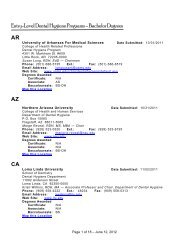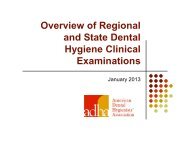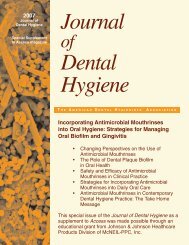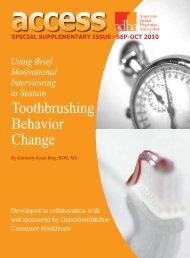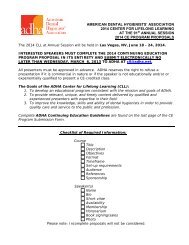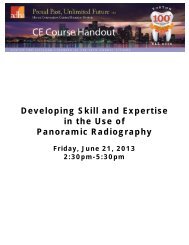Relationship Between Oral Health and Systemic Disease - American ...
Relationship Between Oral Health and Systemic Disease - American ...
Relationship Between Oral Health and Systemic Disease - American ...
You also want an ePaper? Increase the reach of your titles
YUMPU automatically turns print PDFs into web optimized ePapers that Google loves.
Figure 2: Connection between periodontal disease <strong>and</strong> atherosclerosisFrom: Dave S, Batista EL Jr, Van Dyke TE: Cardiovascular disease <strong>and</strong> periodontal diseases:commonality <strong>and</strong> causation. Compend Cont Educ Dent. 2004; 25(7) (Suppl 1):26-37.valis can induce platelet aggregation, a component of atheroma<strong>and</strong> thrombus formation. 19 This suggests a possible invasion ofatheromas by oral pathogens as well as a possible contributionto their development. However, causality has yet to be established.Animal model studies investigating the relationshipbetween CVD <strong>and</strong> periodontal disease have demonstrated thatclinically induced oral infection with P. gingivalis will increaseatheroma size <strong>and</strong> elevate CRP levels. 20 More recently, a studyof humans reported a positive independent association betweencarotid intima-media thickness (IMT) <strong>and</strong> bacterial burdenincluding P. gingivalis, Actinobacillus actinomycetemcomitans,Treponema denticola, <strong>and</strong> Tannerella forsythensis. 21 Figure 2represents the proposed connection between periodontal disease<strong>and</strong> atherosclerosis.It is also thought that an autoimmune response may beinvolved in the development of atherosclerosis. Most humanshave immune reactions against microbial heat-shock protein 60(HSP60). Antibodies against bacterial versions of this proteinmay cross-react with human HSP60, causing an autoimmuneresponse <strong>and</strong> stimulating athersosclerosis. 4Diabetes mellitus is another systemic condition with oralinflammatory connections. One of the major complications ofdiabetes is periodontitis. 22 While diabetes increases the probabilityof developing periodontal disease 22-24 , periodontitis alsoincreases the risk of poor glycemic control in people with diabeteswhen compared to those individuals with diabetes withoutperiodontitis. 25 Fortunately, periodontal treatment canimprove glycemic control by reducingthe bacterial burden <strong>and</strong> theinflammatory response. 26-28There are several biologicalmechanisms proposed to explain theincreased incidence <strong>and</strong> severity ofperiodontal disease in individualswith diabetes. Diabetes tends toincrease susceptibility to infection—including oral infection—<strong>and</strong> thedisease itself decreases the effectivenessof cells that kill bacteria.Another explanation is thatinflammation is enhanced in thosewith diabetes. Research has demonstratedelevated levels of inflammatorymediators in the gingival crevicularfluid of periodontal pockets of poorlycontrolled patients with diabetes ascompared to those without diabetesor those with diabetes who are wellcontrolled. These patients had significantperiodontal destruction with anequivalent bacterial challenge. 24,29,30 Inparticular, the proinflammatorycytokine, TNF-α, plays a major rolein this process. TNF-α has a significantrole in insulin resistance, the primarycause of type 2 diabetes. It isproduced in large quantities by fat cells. Periodontitis has alsobeen associated with increased levels of TNF-α. Elevated levels ofTNF-α may lead to greater bone loss by killing cells that repairdamaged connective tissue or bone <strong>and</strong> may exacerbate insulinresistance <strong>and</strong> worsen glycemic control. 31-33It has also been hypothesized that diabetes interferes withthe capacity to form new bone after periodontal diseases havecaused bone resorption. Graves, et al., studied genetically diabeticmice with type 2 diabetes <strong>and</strong> nondiabetic littermates byinjecting them with P. gingivalis. The death of osteoblasts wasmeasured, <strong>and</strong> results indicated that there was a higher <strong>and</strong>more prolonged rate of osteoblast cell death in the diabeticgroup. It was concluded that the capacity to repair a bonydefect by producing new bone would be severely limited whenosteoblasts died prematurely. Yet further study is needed in thisarea to refine this concept. 34As with CVD <strong>and</strong> diabetes mellitus, there is a relationshipbetween oral infection <strong>and</strong> respiratory disease. In particular,chronic obstructive pulmonary disease (COPD) <strong>and</strong> pneumoniahave been associated with poor oral health. 35-38 It is likelythat oral biofilm serves as a reservoir of infection for respiratorybacteria. Specifically, Pseudomonas aeruginosa, Staphylococcusaureus, <strong>and</strong> enteric bacteria that has been shown to colonize theteeth of patients admitted to hospitals or long-term care facilities.These bacteria may be released into saliva <strong>and</strong> then aspiratedinto the lower airway causing infection. 4 Another vehicle bywhich bacteria from the oral cavity can be introduced into therespiratory system is intubation.4 access—special supplemental issue—april 2006





